3 markets for aggressive traders
Last week’s weakness
caused me to take partial profits in some top themes, but this week’s
strength is improving the short-term outlook markedly. Aggressive traders could
even rebuy the partial positions exited in Japan, Korea, and EM’s as these
markets appear to have held up and reversed off of corrections.
Just as with last week, other leaders still look good such as oil service,
resource plays, South Africa, China, and Brazilian banks (after a surprising 75
bp cut in rates in Brazil with MORE coming) , and precious and base metals. Base
metals are nearly vertical and investors should consider tightening stops on all
but core positions. And in fact for most of these top RS sectors and countries
our best trading advice is to hold core positions and tighten stops on the rest
and let ‘em ride. Remember though that we still recommend lighter than normal
allocation as a starting point.
Our basic strategy of buying strictly only those stocks meeting our rigid
criteria and selling short those doing the same on breakouts has had more new
trades in the last month than in the six months prior, and so far these new
trades are doing quite well.
Our model portfolio followed in
TradingMarkets.com with specific entry/exit/ops levels from 1999 through May of
2003 was up 41% in 1999, 82% in 2000, 16.5% in 2001, 7.58% in 2002, and we
stopped specific recommendations up around 5% in May 2003 (strict following of
our US only methodologies should have had portfolios up 17% for the year 2003) —
all on worst drawdown of under 7%. This did not include our foreign stock
recommendations that had spectacular performance in 2003.
Over the past week in our Top RS/EPS New Highs
list published on TradingMarkets.com, we had readings of 128, 131, 73, 127, and
112 with 47 breakouts of 4+ week ranges, no valid trades and close calls in ARS,
CLF, and STO. This week, our bottom RS/EPS New Lows recorded readings of 13, 9,
12, 8, and 9 with 5 breakdowns of 4+ week ranges, no valid trades and no close
calls. The “model†portfolio of trades meeting criteria is now long TRAD, CIB,
BOOM, TKR, GG, and RVSN. New highs were seen this week in TRAD, CIB, BOOM, TKR,
GG, and RVSN — basically our whole list. Move up stops and let ‘em ride here
too.
 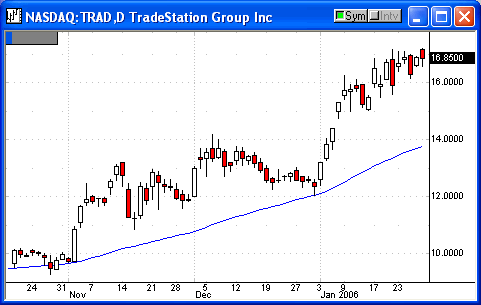
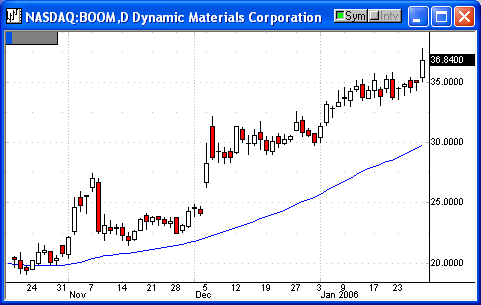
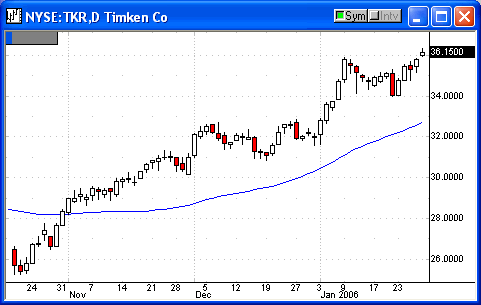
For those not familiar with our long/short
strategies, we suggest you review my book The Hedge Fund Edge. Basically, we
have rigorous criteria for potential long stocks that we call “up-fuel,” as well
as rigorous criteria for potential short stocks that we call “down-fuel.” Each
day we review the list of new highs on our “Top RS and EPS New High List”
published on TradingMarkets.com for breakouts of four-week or longer flags, or
of valid cup-and-handles of more than four weeks. Buy trades are taken only on
valid breakouts of stocks that also meet our up-fuel criteria. Shorts are
similarly taken only in stocks meeting our down-fuel criteria that have valid
breakdowns of four-plus-week flags or cup and handles on the downside. In the
U.S. market, continue to only buy or short stocks in leading or lagging
industries according to our group and sub-group new high and low lists. We
continue to buy new long signals and sell short new short signals until our
portfolio is 100% long and 100% short (less aggressive investors stop at 50%
long and 50% short). In early March of 2000, we took half-profits on nearly all
positions and lightened up considerably as a sea of change in the
new-economy/old-economy theme appeared to be upon us. We’ve been effectively
defensive ever since, and did not get to a fully allocated long exposure even
during the 2003 rally.
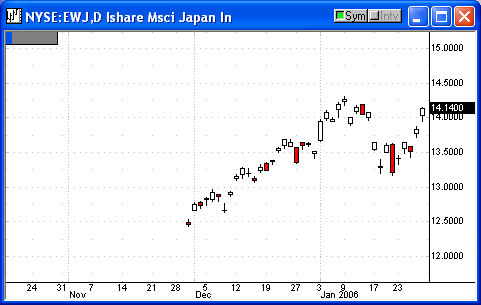
While this rally may seem quite attractive to
many short-term traders, we are continuing to suggest more than normal caution
and milder than normal allocation to top global themes, and for investors to
expect volatility and less than optimum markets. There remain a number of big
risks, and the bull market is now older than average. We suspect that markets
will continue to march irregularly higher throughout the year but urge closely
monitoring key risk factors. A dollar or Yen crisis, a US consumption or housing
crisis, or an increase in Asian inflation (or even Asian Flu) are the primary
concerns investors should watch — and I guess another terrorist act should be
added to this list after this week. Therefore cautious exposure, trading in and
out with minor trends, is probably yet again the best approach to 2006.
Mark Boucher
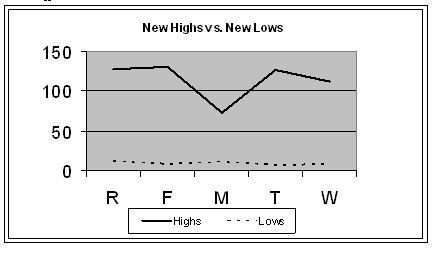
Â
